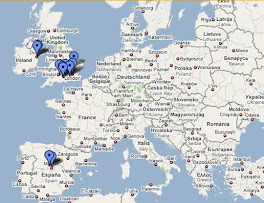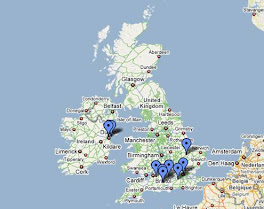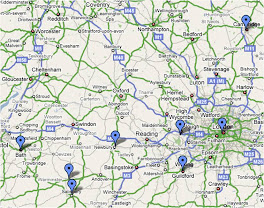Hungry after our visit to the Churchill Museum, I racked my brain for restaurants in London that I remembered having decent food and reasonable prices. "Are you hungry for anything in particular?" I asked Craig as we hopped back on the subway for a quick trip to the British Museum.
"Since I'm in Britain," he began, "I'd really like to try fish and chips while I'm here."
"No problem. There's actually a pretty decent place right across from the museum. Let's grab a bite to eat first and then catch an hour or two at the British Museum before heading back to the hostel to pick up our luggage."
Before that day, I had eaten at this restaurant only once after Bill and I had toured the British Museum. It was our first real experience with British food, and from what I could remember, it didn't seem too bad at the time. In the few months between visits to this restaurant, however, I had visited several British cities and had tasted some incredible dishes during our travels. In short, I had become an amateur food critic and was a bit pickier about sub-par foods.
One of my goals for this trip was to find the best British food for Craig to try while he was in England. Since the British don't have a very nice reputation for their food anyways, my best two options were "bangers & mash" and "fish & chips". Having satisfied the bangers & mash requirement during Craig's first meal in London, I thought that it would be easy to find decent fish & chips near the British Museum -- wrong.
As the waitress brought our platters, I noticed that fish didn't look as crispy and fluffy as I had experienced in other parts of England. Admittedly, it looked more like breaded fish rather than the typical beer-battered fish that marks the dish as distinctly British. Overall, the food was alright -- mediocre but clearly edible. Disappointed, Craig wiped his hands on a napkin and said, "No offense, dear, but I've found better fish & chips back in the States."
Some of you reading this may feel that Craig and I were being a bit harsh with our food criticism and the last few paragraphs were mostly a waste of space, but I promise that there is something to learn from this seemingly unimportant story. Many restaurants in highly-toured cities cater to tourists, and tourists are usually willing to pay high prices for low-quality food simply because the restaurant is located near a main tourist attraction. Local residents, however, know not to waste their money on mediocre restaurants when they can walk a few extra blocks and have a great meal at a much more reasonable price. So my best restaurant advice for anyone touring a European city is to avoid restaurants near main tourists sights -- you will have a better food experience by finding a place further away.
Leaving a tip for the waitress, Craig and I walked over to the British Museum for a few quick hours of free London entertainment. For those who haven't read my earlier posts, the British Museum is the world's largest collection of civilization. Organized by continent, each wing of the museum is arranged chronologically from the ancient Egyptians to more modern inventions of the 19th century. Undoubtedly, the museum's most prized piece is a hefty chunk of the Rosetta Stone, which was the first artifact translating Egyptian hieroglyphics into Demotic and Greek languages. In a sense, it was the ancient world's first translator and an essential key to understanding tomb carvings in Egypt.
Telling Craig what I could remember from my first tour of the British Museum, we strolled through rooms of Egyptian mummies, Greek Parthenon statues, and other various artifacts from the Ancient World. Getting a little burnt out on museum sightseeing, Craig and I walked through the exhibits much faster than my first visit to the British Museum. Though I'd be content to examine the intricacies of the Parthenon statues, Craig isn't as excited by art and quickly moved on to other artifacts. "Let's check out the Americas," he said as we left the European rooms.
"Seriously?" I asked. "Why would you want to look at stuff that we can find back home?"
"It would just be interesting to see, I guess."
Humoring Craig, we walked to the North and South America exhibits -- rooms that Bill and I had purposely skipped on our first visit to the museum. As expected, most of the exhibits were devoted to a large array of Indian artifacts (pipes, stones, headdresses, etc.), but two displays surprised and excited us both.
"No way!" Craig exclaimed. "Gum-gum!"
It's o.k. if you're a little lost by my boyfriend's exclamation, but you might recognize the reference if you've seen Ben Stiller in the movie "Night at the Museum". In the movie, Ben Stiller plays a nighttime security guard who is startled upon realizing that the museum's exhibits come to life every night after the museum closes. The funny part about the movie is that each exhibit has a quirky personality that constantly finds trouble. One of the movie's museum exhibits includes an Easter Island statue that protests in a booming voice until Ben Stiller finds a way to quiet the statue by feeding him bubble gum. Chewing the bum and blowing gigantic bubbles, the statue smiles in self-delight and booms, "Yum-yum. Me want gum-gum."
Though no statues came to life while we were in the British Museum, Craig did manage to find an authentic Easter Island statue in one of the South American exhibits. Pulling a pack of gum out of his pocket, Craig tried offering the statue a piece, but I suppose museum exhibits only come alive after the museum closes...
The second exciting American exhibit hit a little closer to home. Browsing through aisles and aisles of Indian artifacts, Craig abruptly stopped at a small case and astonishingly said, "That's in Ohio!"
Not believing that Ohio would have anything worth showing in the world's most prestigious collection of human civilization, I backtracked to where Craig was standing and glanced in surprise at an entire case devoted to the Hopewell Mounds found in Mound City, Ohio. As a kid, my parents would always try to find time to take our family on vacation. During some years, we would stick around Ohio and visit various museums and Native American burial grounds dotting the state. Not too long ago, our family visited Mound City and hiked around the mounds learning tidbits about Hopewell culture and burial customs. Craig actually grew up near Mound City and was shocked to see his hometown area in a European museum. Reading the museum placard about the burial mounds, I was reminded how important sights of human civilization never seem all that important when they're near home. For travelers, however, they can be quite interesting and leave a lasting impression.
Glancing at my watch, I linked my arm around Craig and said, "Well, dear, we should probably start moving out of here so that we can catch our flight to Paris tonight."
Both ready to leave, we walked out of the British Museum and began the long trek back to the hostel to pick up our luggage. Stopping on our walk to the subway at a Scottish wool shop, Craig spent a few minutes perusing through the cashmere scarves and sweaters before purchasing a few Christmas gifts and hopping back onto the subway. Nervously glancing at my watch every few minutes or so, we managed to quickly grab our bags at the hostel and travel to the nearest station to catch the next train to Luton Airport.
"Isn't it incredible?!" I exclaimed as we waited for our train to arrive. "We woke up this morning in London and will be asleep tonight in Paris!"
Friday, July 18, 2008
Subscribe to:
Post Comments (Atom)











No comments:
Post a Comment